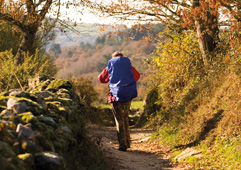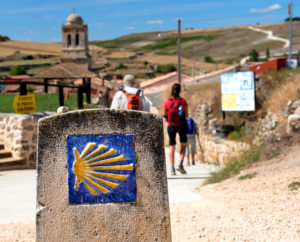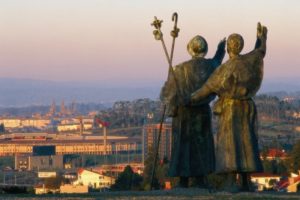CAMINO!
Why book your Camino de Santiago
with Tom Smith Travel?

Camino de Santiago – Spain
 Tom is a Certified Spain Specialist with the Spanish National Tourist Office
Tom is a Certified Spain Specialist with the Spanish National Tourist Office
THE CAMINO IS NOT, REPEAT NOT LIKE TAKING ANOTHER RIDE AT DISNEYLAND. IT IS A PERSONAL JOURNEY, IT IS CUSTOMIZED AND IT IS YOURS. ALLOW ME TO HELP YOU CRAFT YOUR CAMINO!

The Way of St. James or “Camino de Santiago” has existed for over a thousand years. Legend holds that St. James’s remains were carried by boat from Jerusalem to northern Spain where he was buried on the site of what is now the city of Santiago de Compostela. Today thousands of travelers set out each year to make their way to Santiago. Most travel by foot, some by bicycle.
In addition to people undertaking a religious pilgrimage, the majority are travelers and hikers who walk the route for non-religious reasons: travel, sport. Many consider the experience a spiritual adventure or retreat to remove themselves from the bustle of modern life.
Symbols of the Camino de Santiago
The ScallopThe scallop shell, has long been the symbol of the Camino de Santiago. It is found along each route on markers and posts along the way guiding the pilgrim towards Santiago.
“Credencial” or pilgrim’s passport
Most pilgrims carry a “Credencial”, or pilgrims passport which is stamped at each town where the pilgrim has stayed. It serves as proof that the journey is accomplished according to an official route.The stamped”CredA Compostelaencial” is also necessary if you want to obtain a “Compostela”: a certificate of accomplishment given to pilgrims on completing the Way. To earn the “Compostela” one needs to walk a minimum of 100 km or cycle at least 200 km.
Here follows a selection of packages available if you want to do “The Way”
- CAMBADOS & MARITIME WAY OF SANTIAGO 5 days/4 nights
LEVEL OF DIFFICULTY: Easy to Medium
For all walkers, although some prior training is recommended. Only 1 walking stage. Moderately uneven grade, some dirt and stone roads.
– By private car & driver , 4 participants required. Cambados, Padron, Santiago de Compostela
2. RIAS BAIXAS & SANTIAGO – WITH COOKING CLASS 5 days 4 nights
Private tour with local guide and cooking class
4 participants required
Pontevedra, Cambados, Fisterra, Santiago de Compostela 4 participants required
3. LUGO TO SANTIAGO DE COMPOSTELA – THE LAST 100 KMS 7 Days – 6 Nights
THE PRIMITIVE WAY – Unescorted
LEVEL OF DIFFICULTY: Medium
For avid walkers, prior training highly recommended. Moderately uneven grade, some dirt and stone roads
Lugo, Ponte Ferreira, Melide, Arzua, Rua, Santiago de Compostela
4. TUI TO SANTIAGO DE COMPOSTELA 7 Days – 6 Nights
THE PORTUGUESE WAY – Unescorted
LEVEL OF DIFFICULTY: Medium
For avid walkers, prior training highly recommended. Moderately uneven grade, some dirt and stone roads
Tui, O Porriño, Redondela, Pontevedra, Caldas de Reis, Padron, Santiago de Compostela
5. O CEBREIRO TO SANTIAGO – The Best Stages of the Way 7 Days – 6 Nights
O Cebreiro, Samos, Mouzos, Portomarin, Palas de Rei, Melide, Ribadiso, Rua, Santiago
LEVEL OF DIFFICULTY: Easy to Medium
For all walkers, although some prior training is recommended. Moderately uneven grade, some dirt and stone roads.
THE FRENCH WAY – Unescorted
6. SARRIA TO SANTIAGO DE COMPOSTELA – LAST 100 KMS 8 days 7 nights
LEVEL OF DIFFICULTY: Medium
For avid walkers, prior training highly recommended. Moderately uneven grade, some dirt and stone roads
THE FRENCH WAY – Unescorted
Sarria, Portomarin, Lestedo, Melide, Arzua, Rua, Santiago de Compostela 8/7
7. RONCESVALLES TO LOGROÑO 8 days 7 nights
THE FRENCH WAY – Unescorted
LEVEL OF DIFFICULTY: Medium to High
For avid walkers, prior training expressley recommended. Moderately uneven grade, some dirt and stone roads
Roncesvalles, Zubiri, Pamplona, Puente la Reina, Estella, Los Arcos, Viana, Logroño 8/7
8. LEON TO SANTIAGO DE COMPOSTELA BY MOUNTAIN BIKE – THE LAST 200 KMS 8 days 7 nights
LEVEL OF DIFFICULTY: Medium to High
For avid bikers, prior training highly recommended. Moderately uneven grade, some dirt and stone roads
THE FRENCH WAY – Unescorted
Leon, Astorga, Ponferrada, O Cebreiro, Portomarin, Arzua, Santiago de Compostela 8/7
9. SAN SEBASTIAN TO BILBAO 8 days 7 nights
THE NORTHERN WAY – Unescorted
LEVEL OF DIFFICULTY: Medium to High
For experienced walkers in excellent shape. Prior training expressly recommended. Uneven grade, some dirt and stone roads
San Sebastián, Getaria, Deba, Markina, Gernika, Lezama, Bilbao 8/7
10. PONFERRADA TO SANTIAGO DE COMPOSTELA 13 days 12 nights
THE FRENCH WAY – Unescorted
LEVEL OF DIFFICULTY: Medium
For avid walkers, prior training expressly recommended. Moderately uneven grade, some dirt and stone roads
Ponferrada, Camponaraya, Villafranca del Bierzo, Herrerias, O Cebreiro, Triacastela, Sarria, Portomarin, Lestedo, Melide, Arzua, Rua Santiago de Compostela 13/12
11. LEON TO SANTIAGO DE COMPOSTELA 16 days 15 nights
THE FRENCH WAY – Unescorted
LEVEL OF DIFFICULTY: Medium
For avid walkers, prior training expressly recommended. Moderately uneven grade, some dirt and stone roads
Leon, Hospital de Orbigo, Santo Toribio, Astorga, Rabanal del Camino, Molinaseca, Ponferrada, Camponaraya, Villafranca del Bierzo, Herrerias, O Cebreiro, Triacastela, Sarria, Triacastela, Sarria, Portomarin, Lestedo, Melide, Arzua, Rua, Santiago de Compostela 16/15
12. RONCESVALLES TO SANTIAGO 35 days 34 nights
THE ENTIRE FRENCH WAY OF ST. JAMES – Unescorted
LEVEL OF DIFFICULTY: Medium to High
For avid walkers, prior training expressly recommended. Moderately uneven grade, some dirt and stone roads
Roncesvalles, Zubiri, Pamplona, Puente de la Reina, Estella, Viana, Logono, Najera, Santo Domingo de la Calzada, Atapuerca, Burgos, Carrion de los Condes, Sahagun, Leon, Astorga, Ponferrada, Villafranca del Bierzo, O Cebreiro, Sarria, Portomarin, Lestedo, Melide, Arzua, Rua, Santiago de Compostela 35/34
FREQUENTLY ASKED QUESTIONS:
Can I get a detailed, day-to-day itinerary?
Yes, Tom Smith Travel will be happy to send you a detailed itinerary on any of the above 12 itineraries.
How do I arrive to the starting point?
Tom Smith Travel and Spain is More can help you arrange a transportation from the closest airport to your starting point. We can also arrange train tickets through Renfe (Spanish Railways) from most Spanish cities.
What can I expect from this trip?
You will live an unforgettable experience, away from the bustle of everyday life. This is a trip that you can do in total liberty, on foot or by bicycle, and at your own pace as this is not a race. Your luggage (maximum 1 piece, 44 lbs) will be carried for you from one destination to the next. We provide you with all the necessary expert advice, information and documentation that you require to complete your journey safely: local maps detailing your route, vouchers for your lodgings, tags for your luggage and a travelers notebook for your trip with descriptions on each daily walking or biking route.
What is the “Compostela”
The “Compostela” is a certificate of accomplishment given to pilgrims that have completed the Camino de Santiago upon presentation of your stamped “Credendial” or Pilgrims Passport. In order to receive the “Compostela” you must complete the last 100 km walking or 200 km cycling. You obtain the “Compostela” at the Office of the Pilgrim located a few meters from the Platerias façade of the Santiago Cathedral.
Where do I obtain a Pilgrims Passport?
The “Credencial” or Pilgrims Passport will be provided to you in Spain at the beginning of your trip. It is part of the travel materials and insurance information provided upon arrival to your starting point.
Where do I receive my trip documentation?
You will receive most of your documentation prior to your departure so that you can review it and prepare for your Camino. Other documentation will be delivered at your first hotel.
When can I take this trip?
You can take this trip starting any day of the year. The Camino offers diverse countryside and conditions depend on the season and time of year. Consult the weather of Galicia before arranging your trip. Rainy season is from November through February. March through June and September through October are optimum months for the Camino. The summer months of July and August can be somewhat more challenging due to the warmer weather.
What is the profile of the traveler on this trip?
This trip is suitable to any person who enjoys a normal physical condition. We do however highly recommend that you do some training, especially those persons who are not accustomed to walking or cycling for longer periods of time.
Can I travel with children?
Yes, older children are welcome on the trip as long as they are energetic and accustomed to walking long distances on successive days.
HOW TO PREPARE FOR THE TRIP
Do I need physical preparation prior to the trip?
Although this trip is suitable for for any person with normal physical condition, we recommend training for a few weeks prior to your trip, especially for those not accustomed to walking or biking for longer distances. We highly recommend taking very comfortable walking/biking shoes that have been previously broken in, so as to avoid blisters, bruises and discomfort.
What items do I need to complete the Camino?
We recommend a light, comfortable weatherproof backpack which you will carry on every stage and that must contain indispensable items for your walk (water bottle, personal documents, a cell phone, snacks, etc. We recommend broken in walking shoes/boots with which you are used to waking, light comfortable clothing, rain gear, a cap or hat, sun screen and sun glasses. During nighttime, warmer clothing such as a sweater or jacket are necessary. A walking stick can help you walk in a more relaxed manner during the more challenging stages. A photo camera and a notebook are also very recommendable. You should always start you day with a hearty breakfast and always take some snacks with you every day such as fruit, dried fruit, energy bar or chocolate. The most important is a full water bottle.
ABOUT THE CAMINO AND ITS SERVICES
Where does the Camino take place?
The route will take you through many rural country roads and paths as well as local roads with light traffic. On occasions the camino will take you through roads near larger towns and villages with higher density of traffic.
How is the grade?
There are no major grade changes. The beautiful Galician countryside is filled with mostly mild inclines and declines, valleys and mountains, rivers and streams. It can be said that the Way is relatively easy, it is always very beautiful. The major difficulty could be the total distance covered to complete your route, especially in the colder months (Nov-Feb) or warmer months (Jul-Aug).
Is the Camino dangerous?
Absolutely not. The Camino does not present any danger whatsoever. However, it is recommended that you take the normal safety precautions as you would anywhere else.
Is the Camino well outlined/marked?
You will see many markers along the Camino, they are well positioned and clear throughout the route. Look for the scallop shell which is the symbol of the Camino de Santiago. We also provide you with our travelers notebook in case you have any doubts throughout your journey at any given time. It is very rare to get lost. If you do, there are many places to stop and ask other travelers or the locals for directions.
What services are available along the Camino?
You will find many small hamlets, towns and villages along the Way where you will find all sorts of services: pharmacies, medical services, supermarkets, restaurants, cafes and local tourist offices. In some villages, during the summer you can even swim in the local pool or in the nearby river or creek. You can also find massage services after a long days walk.
Is lunch available along the Way?
There are many options available for you to have lunch along the Camino: from sandwiches to drinks to sit-down meals at restaurants or pic-nics on the side of the road, etc. Your travelers notebook contains recommendations for lunch.
WHEN ON THE CAMINO
What is the starting time for each stage?
We recommend starting early, after enjoying a hearty breakfast, at about 8:30am. The majority of hotels and manor houses offer breakfast service from very early in the morning. In any case you can start your walk according to your wishes. You should normally finalize your stage at or about normal lunch time – this way you can relax and enjoy the rest of the day at your leisure and discover these fantastic towns and villages.
How does the luggage transportation work?
You can only take 1 piece of luggage (max 44 lbs). We will transport your luggage every day from your originating town to the next town while you travel. Your luggage will be waiting for you at your next hotel. You will be provided with special luggage tags for your luggage with your documentation. Please make sure that your luggage is closed and properly locked.
What happens if I’m on the Camino and no longer able to continue?
If you can no longer continue your walk or bicycle, we provide you with support telephone numbers that you may call and we will send a car in a short time to pick you up and take you to the next location.
Can I drink from the water fountains found along the Camino?
Although the water from the fountains along the Camino are usually safe, we do not recommend you drink from them and highly recommend drinking only bottled mineral water.
Pricing and cost. Each of the different itineraries has a price. Call Tom Smith Travel for the current rates.

Tom Smith Travel -The Travel Society – A Virtuoso Member
P.O. Box 28134 Portland OR 97228 USA
Tel. 503 477 5341 Email: tom@tomsmithtravel.com
Why should you use a Virtuoso travel advisor?



